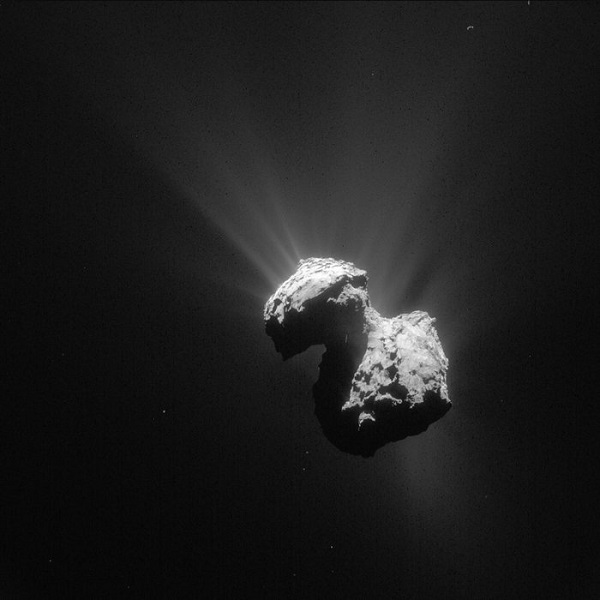Observations from the European Space Agency’s Rosetta spacecraft show that Comet 67P/Churyumov-Gerasimenko has its own aurora.

ESA / Rosetta / NAVCAM
Observations from the European Space Agency’s Rosetta spacecraft show that Comet 67P/ Churyumov-Gerasimenko (Comet 67P for short) has its own aurora.
This little rubber duck-shaped world has no magnetic field, as Earth does, to channel energetic particles flying outward from the Sun. So it doesn’t have “Northern Lights” in the sense that we know them — those eerily ghostlike, curtain-shaped emissions seen mostly in a region ringing Earth’s poles. Instead, researcher Marina Galand (Imperial College London) says, “They would be kind of fuzzy, with brightness smoothly changing with latitude and longitude.”
That is, that’s how they’d look if we could see them with our own eyes, at visible wavelengths — Rosetta captured Comet 67P’s fuzzy aurora at far-ultraviolet wavelengths, Galand and others report in Nature Astronomy.
A Cometary Lightshow
The team used the Alice spectrograph aboard the spacecraft to detect ultraviolet emissions from hydrogen and oxygen atoms, which probably originated in water molecules in the comet’s extended atmosphere, or coma.
Analysis showed that the emissions come from interactions with fast-flying electrons in the solar wind that’s always blasting away from the Sun. (The source is important: If the fast-moving electrons came from the comet itself, produced when molecules absorb solar photons, then the resulting light would be called “dayglow,” not aurora.)

ESA / Rosetta / NAVCAM
The kind of aurora at Comet 67P, where electrons split oxygen away from molecules and excite the individual atoms, is similar to the kind seen on Jupiter’s moons Ganymede and Europa. But unlike the moons, Comet 67P has no magnetic field.
“At a planet which has a magnetic field, it is easy to accelerate charged particles in the magnetized environment,” Galand explains. “However, to generate a magnetic field is not a requirement for a body to host aurora.” In the case of Comet 67P, electrons are accelerated as the comet’s coma interacts with the solar wind, which carries along its own magnetic field.
That makes for a decidedly different lightshow: Earth’s magnetic fields make the Northern Lights dance, but a comet’s aurora simply glows.
Universal Aurorae
Astronomers have seen aurorae around many worlds, from moons and planets in the solar system to rogue brown dwarfs wandering interstellar space. But they have only rarely been observed at comets.
“We already know that comets have extreme-ultraviolet aurorae,” says Carey Lisse (Johns Hopkins APL). Lisse and colleagues had seen such emission coming from Comet Hyakutake (C/1996 B2) more than 20 years ago. Heavy ions from the solar wind interacted with the atoms and molecules in the comet’s coma to create these emissions. “So the other charged part of the solar wind, the light electrons, should also be interacting with coma gases,” he adds. “And here is the evidence.”
Indeed, the process should be universal, even if rarely observed. “The process which we have identified is taking place when the comet is not too close from the Sun, though close enough to have an envelope of gas around it,” Galand says. “Given that this condition is fulfilled, there is no reason why such a process would not be taking place at other comets.”
 0
0









Comments
You must be logged in to post a comment.